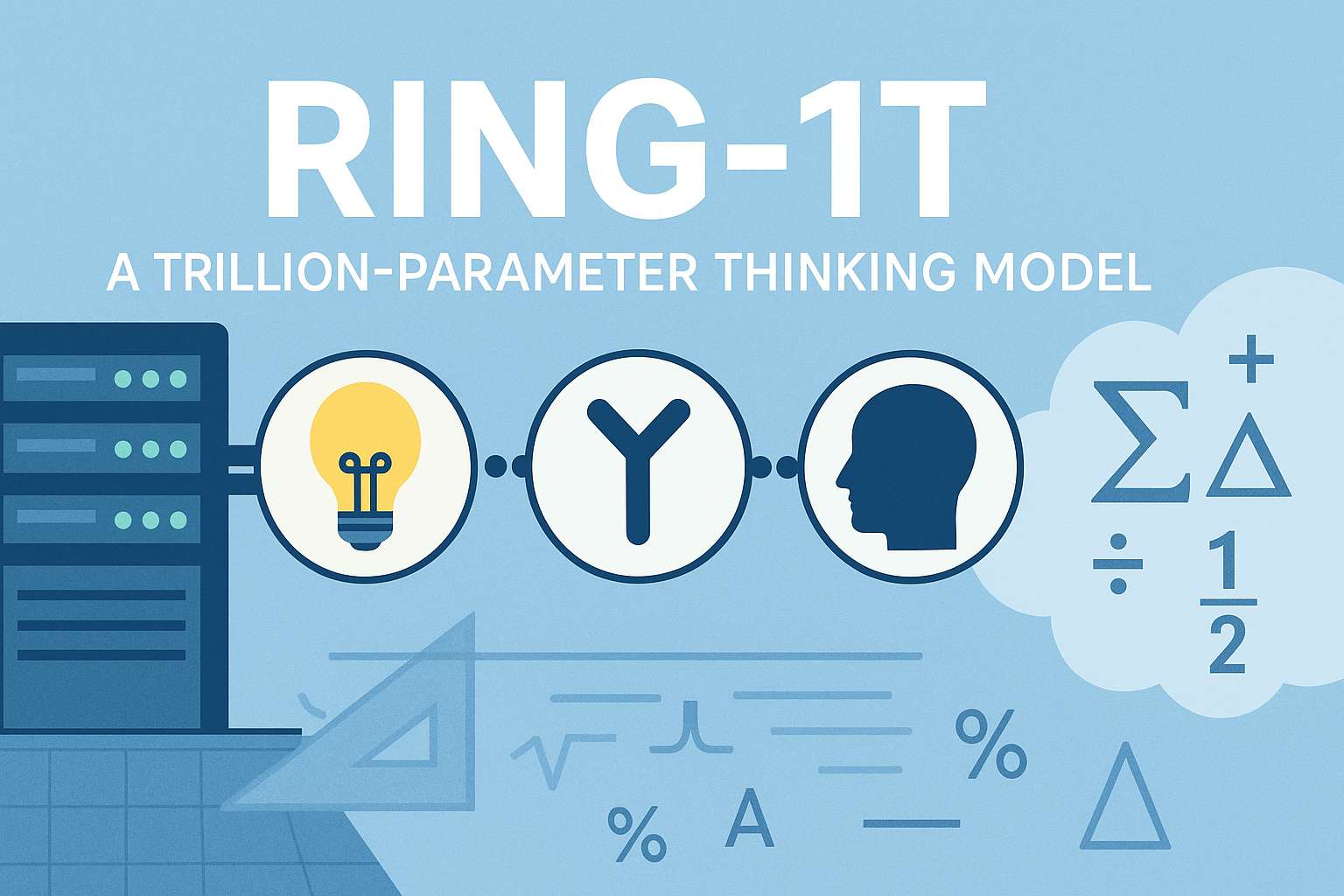Ring-1T: The Trillion-Parameter Thinking Model from Ant Group
Ring-1T: The Trillion-Parameter Thinking Model from Ant Group

1. Introduction
Just ten days after releasing Ling-1T, Ant Group made headlines again by unveiling Ring-1T — the world’s first open-source trillion-parameter thinking model.
Unlike Ling-1T, which focuses on general language understanding, Ring-1T is designed specifically for deep reasoning and logical thinking. In fact, during internal tests on the International Mathematical Olympiad (IMO) benchmark, Ring-1T achieved silver-medal performance, marking a huge leap for open-source AI.
In this article, we’ll walk through what makes Ring-1T unique, its performance highlights, and — most importantly — how you can install, run, and experiment with this groundbreaking “thinking” model.
2. What Is Ring-1T?
Ring-1T is an open-source “thinking-type” large language model developed by Ant Group’s Bailing AI team.
It’s built on a trillion-parameter Mixture-of-Experts (MoE) architecture — meaning only a small subset of experts (about 50 B active parameters) are activated for each token, dramatically improving inference efficiency.
The model goes beyond standard LLMs by incorporating reasoning-focused reinforcement learning:
- RLVR (Reinforcement Learning from Verifiable Rewards): trains the model to verify its reasoning chain.
- RLHF (Reinforcement Learning from Human Feedback): balances reasoning accuracy with natural language fluency.
These techniques are powered by Ant’s self-developed systems:
- IcePop Algorithm (“Popsicle”) — filters unstable gradients to stabilize trillion-scale training.
- ASystem RL Framework — handles distributed GPU scheduling, reward evaluation, and serverless sandbox execution.
🔗 Model Pages
3. Key Highlights
Trillion-Parameter MoE Design
- Uses sparse activation to maintain high efficiency while achieving unprecedented reasoning capacity.
Reinforcement-Enhanced Thinking Ability
- RLVR enables multi-step reasoning with verifiable logic chains.
World-Class Math and Coding Skills
- Achieved IMO silver medal level in mathematics; solved 5/6 problems in the ICPC World Finals 2025.
Stable Large-Scale RL via IcePop
- Monitors training “temperature” to prevent gradient explosion or collapse.
ASystem Infrastructure
- Supports trillion-scale distributed reinforcement learning with GPU peer-to-peer synchronization.
4. How to Install and Use Ring-1T
You can easily try Ring-1T using HuggingFace, ModelScope, or OpenRouter APIs.
Method 1 — HuggingFace + Transformers
pip install transformers accelerate vllm
from transformers import AutoTokenizer, AutoModelForCausalLM
model_name = "inclusionAI/Ring-1T"
tokenizer = AutoTokenizer.from_pretrained(model_name)
model = AutoModelForCausalLM.from_pretrained(model_name, device_map="auto", torch_dtype="auto")
prompt = "Prove: if f(x) is an odd function and f(x)+f(1-x)=0, find f(1/2)"
inputs = tokenizer(prompt, return_tensors="pt").to(model.device)
outputs = model.generate(**inputs, max_new_tokens=512)
print(tokenizer.decode(outputs[0], skip_special_tokens=True))Method 2 — OpenRouter API
curl https://openrouter.ai/api/v1/chat/completions \
-H "Authorization: Bearer YOUR_API_KEY" \
-H "Content-Type: application/json" \
-d '{
"model": "inclusionAI/ring-1t",
"messages": [{"role": "user", "content": "Write a simple Flappy Bird game in Python"}]
}'Method 3 — ModelScope Local Inference
pip install modelscope
from modelscope import AutoModelForCausalLM, AutoTokenizer
model = AutoModelForCausalLM.from_pretrained("inclusionAI/Ring-1T", device_map="auto")
tokenizer = AutoTokenizer.from_pretrained("inclusionAI/Ring-1T")
inputs = tokenizer("Generate a simple Snake game with scoring and pause function", return_tensors="pt")
outputs = model.generate(**inputs, max_new_tokens=300)
print(tokenizer.decode(outputs[0], skip_special_tokens=True))5. Performance Overview
| Model | Parameters | Reasoning (ARC-AGI-v1) | Math (AIME25) | Code (LiveCodeBench) | Overall (Arena-Hard-v2) |
|---|---|---|---|---|---|
| Ring-1T | 1 T | Open-source SOTA | ≈ IMO Silver Medal | Strong | 2nd, just below GPT-5-Thinking |
| Ling-1T | 1 T | Good | Moderate | Good | 3rd tier |
| DeepSeek-V3.1 | 671 B | High | High | High | 2nd tier |
| Gemini-2.5-Pro | N/A | High | High | High | Closed-source top |
| GPT-5-Thinking (High) | N/A | Best | Best | Best | 1st tier |
6. Usage Tips
Use Reasoning Prompts
Add instructions like “Think step by step” or “Verify each reasoning step” to get more accurate answers.Leverage Long Contexts
Supports up to 128 K tokens, ideal for academic papers, codebases, or reasoning datasets.Language Support
Works best in English and Chinese. Multilingual reasoning still under optimization.Hardware Recommendation
Minimum: 48 GB GPU memory (A100/H100/L40S)
Use FP8 or bfloat16 inference for efficiency.
7. Real-World Testing
During testing, Ring-1T successfully generated a playable Flappy Bird clone in HTML and JavaScript — complete with animation, collision detection, and scoring logic.
For reasoning tasks, the model demonstrates a human-like reasoning flow: outlining assumptions, validating logic, and providing structured explanations.
In creative writing, Ring-1T generated a podcast script about Su Shi and Zhang Dun’s political feud, blending historical accuracy with storytelling flair — even including suggested sound effects.
8. Editor’s Notes
If you’re a:
Researcher → Ring-1T offers a goldmine for studying reasoning-enhanced RLHF.
Developer → Great for building educational, logic, or math-related apps.
Content Creator → Reliable for long-form storytelling and interactive writing.
Ring-1T proves that open-source models can now compete directly with closed-source giants like GPT-5.
Though minor issues like language mix and self-consistency remain, its trillion-scale architecture and open accessibility mark a new milestone for the open AI ecosystem.
9. FAQ
Q1: What’s the difference between Ring-1T and Ling-1T?
A: Ling-1T is a general-purpose LLM, while Ring-1T is optimized for deep reasoning, logical analysis, and mathematical problem-solving.
Q2: What hardware do I need to run it?
A: At least 48 GB of GPU memory (A100/H100/L40S). Distributed inference with vLLM or DeepSpeed is recommended for lower VRAM systems.
Q3: Can I run it on CPU?
A: Technically yes, but it’s extremely slow. You’re better off running it on a GPU cloud (e.g., LightNode, AWS, or RunPod).
Q4: Does it support Chinese?
A: Yes. Ring-1T supports both English and Chinese input, with highly stable reasoning performance in Chinese.
Q5: Is it fully open-source?
A: Yes — the model weights and configs are available under an open license on HuggingFace and ModelScope.
Q6: How to get more accurate reasoning outputs?
A: Add structured reasoning prompts like “Explain your reasoning step by step” or “Validate each step logically.”
Q7: Can it be used commercially?
A: Yes. The model is open-source and can be used for academic, research, and commercial purposes under the stated license.